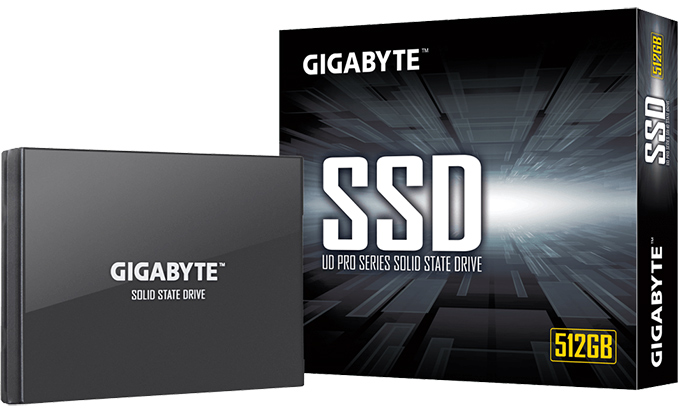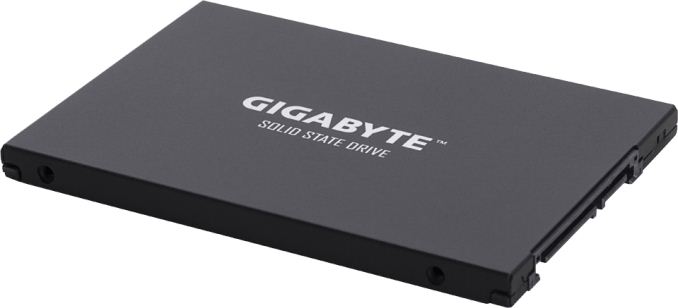GIGABYTE Launches Its First SSDs: Phison PS3110 S10 with Toshiba’s 3D TLC
by Anton Shilov on May 11, 2018 2:15 PM EST
Despite growing demand for SSDs in the recent years, the four leading makers of motherboards have largely stayed out of this market, despite the significant leverage they normally have with commodity products. However after all of this time, GIGABYTE has decided to try its luck and added two SSDs to its lineup of products. The UD PRO-series drives are aimed at entry-level gaming systems, which continues to be the fastest growing segment of the SSD market.
For its first SSDs, GIGABYTE decided to go with a turnkey solution by Phison and Toshiba. The UD PRO-series drives are based on Phison’s PS3110 S10 controller as well as Toshiba’s BICS3 3D TLC NAND memory, a combination introduced by Phison late last year. GIGABYTE’s UD PRO lineup consists of only two models featuring 256 GB and 512 GB configurations (no, GIGABYTE does not offer gigabyte SSDs just now) as well as a SATA 6 Gb/s interface. From performance point of view, GIGABYTE’s UD PRO lineup does not offer anything special. The manufacturer declares up to 530 MB/s sequential read speed and up to 500 MB/s sequential write speed. Meanwhile random performance is up to 80K read IOPS and up to 75K write IOPS.
Phison’s PS3110 S10 controller was originally designed for 2D MLC- and 2D TLC-based SSDs with first drives emerging in Q4 2014 – Q1 2015. The controller features four processing cores as well as eight NAND channels and 32 CE targets, so potentially it can offer a very decent performance level when paired with appropriate memory. Meanwhile, the chip supports 120bit/2KB BCH-based ECC algorithm that is almost never used for 3D TLC-powered drives (such SSDs rely on LDPC-based ECC technologies). Nonetheless, Phison and Toshiba have certified the S10 to work with 3D TLC memory, enabling SSD makers to build very cost-efficient SSDs using proven controllers. Keep in mind that turnkey solutions by Phison and Toshiba usually include a controller, NAND memory, a reference design, and firmware. At times, Phison may even offer assembly services, essentially selling actual drives to its customers. Therefore, retrofitting the PS3110 S10 for 3D TLC essentially saves Phison a lot of R&D money.
From reliability point of view, the UD PRO SSDs from GIGABYTE are speced for 100 TBW (256 GB SKU) and 200 TBW (512 GB SKU), which is 33% below other entry-level drives based on 3D TLC memory, a direct consequence of BCH-based ECC and insufficient overprovisioning. The drives are rated for 1.8 million hours MTBF (again, a bit lower than competing products) and are covered with a three-year warranty (vs. five years in case of other drives).
| GIGABYTE UD PRO Specifications | ||||
| Capacity | 256 GB | 512 GB | ||
| Model Number | UD PRO 256 GB | UD PRO 512 GB | ||
| Controller | Phison PS3110 S10 | |||
| NAND Flash | Toshiba BICS3 3D TLC NAND | |||
| Form-Factor, Interface | 2.5-inch/7-mm, SATA 6 Gbps | |||
| Sequential Read | 530 MB/s | |||
| Sequential Write | 500 MB/s | |||
| Random Read IOPS | 70K IOPS | 80K IOPS | ||
| Random Write IOPS | 40K IOPS | 75K IOPS | ||
| Pseudo-SLC Caching | Supported | |||
| DRAM Buffer | Yes, capacity unknown | |||
| TCG Opal Encryption | No | |||
| Power Consumption | Active | Read | 1.93 W | 2.24 W |
| Write | 2.43 W | 2.61 W | ||
| Idle | 170 mW | |||
| Warranty | 3 years | |||
| MTBF | 1,800,000 hours | |||
| TBW | 100 TB | 200 TB | ||
| Price | $69 | $120 | ||
Although not published on their website, GIGABYTE has announced that they are pricing the drives at $68.99 and $119.99 for the 256GB and 512GB models respectively. This works out to a bit over $0.23/GB for storage, and makes it comparable in price to market leaders such as Crucial's MX500. In the meantime, the company expects the new drives to start showing up at retailers next week.
Finally, GIGABYTE's announcement for the UD PRO series also confirms that the company will be releasing additional drives in the future, including NVMe-based M.2 drives and a PCIe card. Both of these drives will be under the AORUS brand, and presumably will be focused at a higher performance segment of the market.
Related Reading:
Source: GIGABYTE











14 Comments
View All Comments
The Chill Blueberry - Friday, May 11, 2018 - link
Wow, there's a lot of new SSD manufacturers (rebranders) now.LauRoman - Friday, May 11, 2018 - link
As there are power supplies, cases, fans, RAM, motherboardsdeepblue08 - Friday, May 11, 2018 - link
Motherboards???qlum - Friday, May 11, 2018 - link
I only know of nzxt doing this to motherboards.shabby - Friday, May 11, 2018 - link
How long before thermaltake comes out with an ssd?MrSpadge - Friday, May 11, 2018 - link
Only after you can attach a small and noisy fan to it.XabanakFanatik - Friday, May 11, 2018 - link
Either you mixed up the performance numbers or this is the first SSD I've seen with the larger capacity slower than the smaller one.The Chill Blueberry - Friday, May 11, 2018 - link
I thought the same thing, the IOPS should be higher on the larger capacity drive.Ryan Smith - Friday, May 11, 2018 - link
Right you are. Thanks!hojnikb - Sunday, May 13, 2018 - link
It's not really impossible though. There were instances in the past, where higher capacity drives were slightly slower due to overhead associated with having more blocks to deal with.